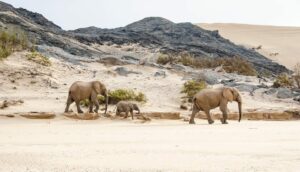
- Profile
- Tour Operators
- Accommodation
- prev
- next
- Get directions
- Website
- Bookmark
- Share
- Become an influencer
- prev
- next
Overview
There are three contiguous protected areas: Iona National Park, the Skeleton Coast Park and the Namib-Naukluft National Park (the latter two in Namibia) which form a continuous block covering some 1,200 km of Namib Desert coastline and adjacent dunes. The altitude in area ranges from sea-level to about 800 m at Posto do Iona and higher in the Tchamalinde Mountains, and there is a gradient in rainfall, from about 100 mm at the coast to 300 mm or more on the eastern boundary of the park. The protected area includes the mouth of the Cunene River, the Baia dos Tigres and extensive sand spit, and about 200 km of Atlantic coastline. There are a variety of desert and semi-desert ecosystems in Iona National Park, including mobile dunes along the coast, calcrete plains, desert grasslands, open woodland, arid shrub land and savannah. As a result of the rainfall gradient, the perennial grasslands in the park lead into semi-arid savannah and, further east, to mopane woodlands.
Before the Angolan civil war, Iona National Park was known as an animal paradise, rich in big game. Unfortunately, illegal hunting and poaching, as well as the eradication of infrastructure have caused considerable damage to Iona, as well as most other national parks in Angola. The wildlife in all the parks have been almost completely wiped out after the devastation wrought by decades of war. However, efforts are now underway to replace most of the lost wildlife. The “Big Five” of Iona National Park now include: Springbok (Gazelle), Kudu, Ostrich, Oryx and (very rare) cheetah. Other animals in the park include mountain zebra, impala, klipspringer, and the quelengue. Although the landscape is empty, many animals (especially Springbok) can still be found inside and outside the park.
Iona National Park is also known for its unique flora – including the stunning Welwitschia Mirabilis (one of the world’s oldest living plants) – and incredible rock formations. The park is also known for its varied birdlife, especially along the coastal pans and river basins. Many rippled rows of sand dunes can be seen near the coast, making this vast, remote landscape a photographer’s dream.
Iona National Park is also home to many indigenous peoples such as the Mucubal and Himba, as well as many Kimbundu groups. Most are subsistent farmers and herders who remain isolated and oblivious to the outside world. The indigenous people of this region have been studied by anthropologists, who say they are the most culturally intact on the African continent.
Location
-
Tombwa, Namibe, Angola
Vital Park Information
Angola
1,200 km
Access to safe drinking water in Angola. ... The sharp increase in access to safe drinking water by 2004 reflects the emergency assistance and humanitarian resources that flowed in following the peace agreement, but in some cases was not sustainable. Angola has witnessed improved access to sanitation in the same period.
Kwanza (AOA)
May, June, July, August, September, October





